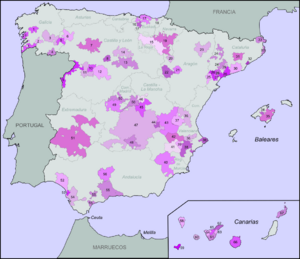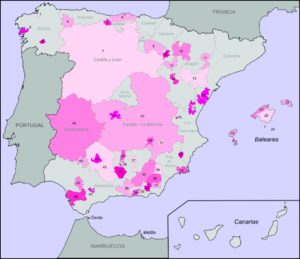Spanish wine regions facts for kids
Spanish wines are famous around the world! In Spain, special rules help make sure that wines are good quality. These rules are like a grading system for wine regions. The main way Spain checks wine quality is called denominación de origen protegida (DOP). This means "protected name of origin." It's similar to how some foods, like special cheeses, can only be called by a certain name if they come from a specific place.
In 2016, the name Denominación de Origen (DO) was updated to Denominación de Origen Protegida (DOP). You might still see DO on some labels, but DOP is the newer, official term. Spain has many wine regions, and each one has its own rules about how the wine is made.
Contents
How Spanish Wine Regions Are Classified
Spain has a system to classify its wine regions. This system helps people know where a wine comes from and what quality to expect. As of 2019, there were 138 wine regions with some kind of special classification.
DOP: Protected Name of Origin
The denominación de origen protegida (DOP) is the most important part of Spain's wine quality system. Think of it as the main group for quality wines.
- Each DOP region has a group called a consejo regulador (control board).
- This board decides things like the region's borders, what types of grapes can be used, how many grapes can be grown, and how strong the wine's alcohol can be.
- There are 96 DOPs in Spain, and they are divided into smaller groups.
DOCa: Highest Quality Wines
Denominación de origen calificada (DOCa) is the highest level for Spanish wines. It's for regions that have very high grape prices and very strict quality checks.
- Rioja was the first region to get DOCa status in 1991.
- Priorat followed in 2003. Priorat uses the Catalan language name, DOQ, which means the same thing.
- These two regions are considered the best in Spain.
DO: Main Quality Regions
Denominación de origen (DO) is the most common quality level. It's part of the DOP system.
- Like DOPs, each DO region has a consejo regulador.
- This board sets rules for the region, including grape types, how much can be grown, and other quality standards.
VP: Special Estate Wines
Vino de pago (VP) means "estate wine." This is a special category for high-quality wines that come from a single, specific vineyard estate.
- A "pago" is a Spanish word for a vineyard estate.
- This category was created in 2003.
VC: Quality Wine with Geographic Indication
Vino de Calidad con indicación geográfica (VC) means "quality wine with geographic indication."
- This category was also created in 2003.
- VC wines are good quality, but they might not meet all the very strict rules of the DO category. They are still better than the IGP category.
IGP: Protected Geographic Indication
Indicación geográfica protegida (IGP) means "protected geographic indication." This level is below the DOP level.
- IGP wines come from a specific place, like a region or country.
- They have certain qualities or a reputation that comes from their geographical origin.
- These wines can also use the traditional name Vino de la Tierra (VT), which means "wine of the land."
VdM: Table Wine
Vino de mesa (VdM) means "table wine." This is the lowest category.
- It includes wines from vineyards that don't have a special classification.
- It can also include wines that have been mixed in a way that takes away their higher classification.
- This category includes simple, everyday wines, but sometimes also expensive wines that are new and don't fit into the traditional classification rules yet.
Wine Regions by Community
Some wine regions, like Cava (a type of sparkling wine) and Rioja, are so big that they are made in more than one part of Spain. But for Vinos de Pago, the location rules are very strict. The wine must come from a very specific piece of land.
Here is a list of some of the main wine regions in Spain, grouped by their larger areas called Autonomous Communities:
| Autonomous Community |
Denominación de Origen Protegido (DOP) Vino de Calidad con Indicación Geográfica (VC) (DOCa and Vino de Pago in bold) |
IGP / Vinos de la Tierra (VT) |
|---|---|---|
| Andalusia |
Condado de Huelva |
Altiplano de Sierra Nevada |
| Aragon |
Calatayud |
Bajo Aragón |
| Asturias | Cangas (VC) | (none) |
| Cantabria | (none) | Costa de Cantabria Liébana |
| Castile and León |
Arlanza Cava (multi-regional) |
Castilla y León |
| Castile-La Mancha |
Almansa |
Castilla |
| Catalonia |
Alella |
(none) |
| Community of Madrid | Vinos de Madrid | (none) |
| Valencian Community |
Alicante |
Castelló |
| Extremadura |
Ribera del Guadiana |
Extremadura |
| Galicia |
Monterrei |
Barbanza e Iria |
| Balearic Islands |
Formentera |
|
| Canary Islands |
Abona |
Canary Islands |
| Foral Community of Navarre |
Navarra |
Ribera del Queiles (multi-regional) |
| Basque Country |
Txacolí de Bizcaia |
(none) |
| Murcia |
Bullas |
Campo de Cartagena |
| La Rioja | Rioja (DOCa) Cava (multi-regional) |
Valles de Sadacia |
See also
 In Spanish: Anexo:Vinos de España para niños
In Spanish: Anexo:Vinos de España para niños



